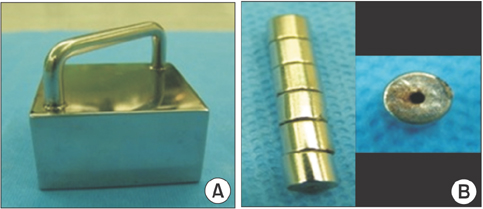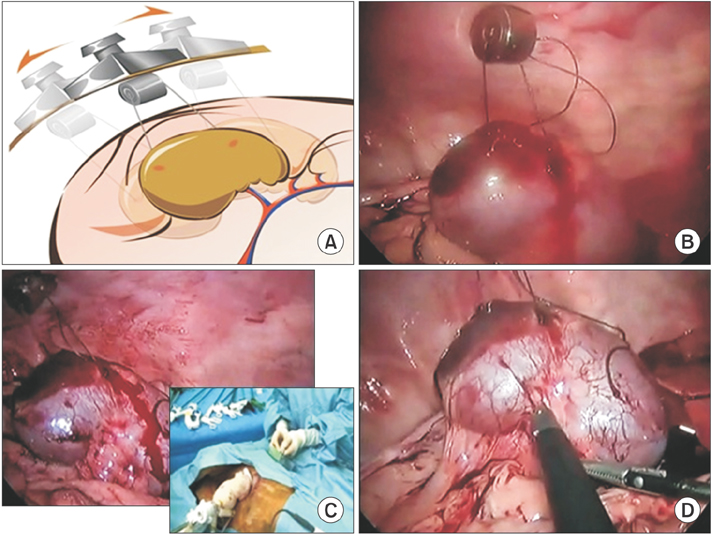Investig Clin Urol.
2016 May;57(3):208-214. 10.4111/icu.2016.57.3.208.
Laparoendoscopic single-site simple nephrectomy using a magnetic anchoring system in a porcine model
- Affiliations
-
- 1Department of Urology, Samsung Medical Center, Sungkyunkwan University School of Medicine, Seoul, Korea. bc2.jung@samsung.com
- 2Department of Urology, Myongji Hospital, Kwandong University College of Medicine, Goyang, Korea.
- KMID: 2426496
- DOI: http://doi.org/10.4111/icu.2016.57.3.208
Abstract
- PURPOSE
Magnetic anchoring devices may reduce the number of port sites needed in laparoscopic surgery. In this study, we prospectively assessed the feasibility of using a magnetic anchoring and guidance system (MAGS) in laparoendoscopic single-site (LESS) surgery performed by novices.
MATERIALS AND METHODS
A total of 10 LESS simple nephrectomies were performed with or without MAGS in a nonsurvival porcine model by 6 operators with no previous LESS surgery experience. After installation of the homemade single port, an intra-abdominal magnet was fixed to the renal parenchyma with suturing and stabilized by an external magnet placed on the flank so that the position of the kidney could be easily changed by moving the external handheld magnet. The length of the procedure and any intraoperative complications were evaluated.
RESULTS
Operative time (mean±standard deviation) was shorter in the group using the magnetic anchoring device (M-LESS-N) than in the group with conventional LESS nephrectomy (C-LESS-N) (63±20.8 minutes vs. 82±40.7 minutes, respectively). Although all nephrectomies were completed uneventfully in the M-LESS-N group, renal vein injury occurred during dissection of the renal hilum in two cases of C-LESS-N and was resolved by simultaneous transection of the renal artery and vein with an Endo-GIA stapler.
CONCLUSIONS
LESS-N using MAGS is a feasible technique for surgeons with no LESS surgery experience. Taking into account the 2 cases of renal vein injury in the C-LESS-N group, the application of MAGS may be beneficial for overcoming the learning curve of LESS surgery.
MeSH Terms
-
Animals
Clinical Competence
Endoscopy/methods
Equipment Design
Feasibility Studies
Female
Intraoperative Period
Laparoscopy/adverse effects/*instrumentation/methods
*Magnetics
Minimally Invasive Surgical Procedures/adverse effects/instrumentation/methods
Models, Animal
Nephrectomy/adverse effects/*instrumentation/methods
Sus scrofa
Figure
Reference
-
1. Best SL, Cadeddu JA. Use of magnetic anchoring and guidance systems to facilitate single trocar laparoscopy. Curr Urol Rep. 2010; 11:29–32.2. White WM, Haber GP, Goel RK, Crouzet S, Stein RJ, Kaouk JH. Single-port urological surgery: single-center experience with the first 100 cases. Urology. 2009; 74:801–804.3. Desai MM, Berger AK, Brandina R, Aron M, Irwin BH, Canes D, et al. Laparoendoscopic single-site surgery: initial hundred patients. Urology. 2009; 74:805–812.4. Stolzenburg JU, Kallidonis P, Hellawell G, Do M, Haefner T, Dietel A, et al. Technique of laparoscopic-endoscopic single-site surgery radical nephrectomy. Eur Urol. 2009; 56:644–650.5. Raman JD, Bensalah K, Bagrodia A, Stern JM, Cadeddu JA. Laboratory and clinical development of single keyhole umbilical nephrectomy. Urology. 2007; 70:1039–1042.6. Kurien A, Rajapurkar S, Sinha L, Mishra S, Ganpule A, Muthu V, et al. First prize: Standard laparoscopic donor nephrectomy versus laparoendoscopic single-site donor nephrectomy: a randomized comparative study. J Endourol. 2011; 25:365–370.7. Park YH, Park JH, Jeong CW, Kim HH. Comparison of laparoendoscopic single-site radical nephrectomy with conventional laparoscopic radical nephrectomy for localized renal-cell carcinoma. J Endourol. 2010; 24:997–1003.8. Tugcu V, Ilbey YO, Mutlu B, Tasci AI. Laparoendoscopic single-site surgery versus standard laparoscopic simple nephrectomy: a prospective randomized study. J Endourol. 2010; 24:1315–1320.9. Cindolo L, Berardinelli F, Gidaro S, Schips L. Laparoendoscopic single-site partial nephrectomy without ischemia. J Endourol. 2010; 24:1997–2002.10. Park S, Bergs RA, Eberhart R, Baker L, Fernandez R, Cadeddu JA. Trocar-less instrumentation for laparoscopy: magnetic positioning of intra-abdominal camera and retractor. Ann Surg. 2007; 245:379–384.11. Zeltser IS, Bergs R, Fernandez R, Baker L, Eberhart R, Cadeddu JA. Single trocar laparoscopic nephrectomy using magnetic anchoring and guidance system in the porcine model. J Urol. 2007; 178:288–291.12. Yin G, Han WK, Faddegon S, Tan YK, Liu ZW, Olweny EO, et al. Laparoendoscopic single site (LESS) in vivo suturing using a magnetic anchoring and guidance system (MAGS) camera in a porcine model: impact on ergonomics and workload. Urology. 2013; 81:80–84.13. Clayman RV, Kavoussi LR, Soper NJ, Dierks SM, Meretyk S, Darcy MD, et al. Laparoscopic nephrectomy: initial case report. J Urol. 1991; 146:278–282.14. Raybourn JH 3rd, Rane A, Sundaram CP. Laparoendoscopic single-site surgery for nephrectomy as a feasible alternative to traditional laparoscopy. Urology. 2010; 75:100–103.15. Jeong BC, Park YH, Han DH, Kim HH. Laparoendoscopic single-site and conventional laparoscopic adrenalectomy: a matched case-control study. J Endourol. 2009; 23:1957–1960.16. Tracy CR, Raman JD, Bagrodia A, Cadeddu JA. Perioperative outcomes in patients undergoing conventional laparoscopic versus laparoendoscopic single-site pyeloplasty. Urology. 2009; 74:1029–1034.17. Best SL, Bergs R, Scott DJ, Fernandez R, Mashaud LB, Cadeddu JA. Solo surgeon laparo-endoscopic single site nephrectomy facilitated by new generation magnetically anchored and guided systems camera. J Endourol. 2012; 26:214–218.18. Cadeddu J, Fernandez R, Desai M, Bergs R, Tracy C, Tang SJ, et al. Novel magnetically guided intra-abdominal camera to facilitate laparoendoscopic single-site surgery: initial human experience. Surg Endosc. 2009; 23:1894–1899.19. Dominguez G, Durand L, De Rosa J, Danguise E, Arozamena C, Ferraina PA. Retraction and triangulation with neodymium magnetic forceps for single-port laparoscopic cholecystectomy. Surg Endosc. 2009; 23:1660–1666.20. Cho YB, Park CM, Chun HK, Yi LJ, Park JH, Yun SH, et al. Transvaginal endoscopic cholecystectomy using a simple magnetic traction system. Minim Invasive Ther Allied Technol. 2011; 20:174–178.21. Cho YB, Park JH, Chun HK, Park CM, Kim HC, Yun SH, et al. Multimedia article. Natural orifice transluminal endoscopic surgery applied to sigmoidectomy in survival animal models: using paired magnetic intra-luminal device. Surg Endosc. 2011; 25:1319–1324.
- Full Text Links
- Actions
-
Cited
- CITED
-
- Close
- Share
- Similar articles
-
- Feasibility of Laparoendoscopic Single-Site Partial Nephrectomy in a Porcine Model
- Robot-assisted laparoendoscopic single-site upper urinary tract surgery with da Vinci Xi surgical system: Initial experience
- Laparoendoscopic Single-Site Surgery With the Second-Generation Single Port Instrument Delivery Extended Reach Surgical System in a Porcine Model
- Laparoendoscopic Single-Site Surgeries: A Single-Center Experience of 171 Consecutive Cases
- Simultaneous Robot-Assisted Laparoendoscopic Single-Site Partial Nephrectomy and Standard Radical Prostatectomy





